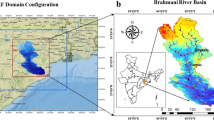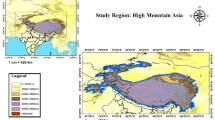Abstract
The regions where the divergence of vertically integrated water vapor flux, averaged over a season or a year, is positive (negative) are sources (sinks) of moisture for the atmosphere. An aerial river is defined as a stream of strong water vapor flux connecting a source and a sink. Moisture flux, its divergence, and sources and sinks over the tropics of South and Central America and the adjoining Atlantic Ocean are obtained for dry years and for wet years in the Amazon Basin. Results show that the Amazon Basin is a sink region for atmospheric moisture in all seasons and that there are two source regions for the moisture in the basin, one situated in the South Atlantic and the other in the North Atlantic, both located equator-ward of the respective subtropical high-pressure centers. The convergence of moisture increases over the Amazon Basin in austral summer, and at the same time it decreases in the Pacific and Atlantic ITCZs. Box model calculations reveal that the wet years, on the average, present about 55 % more moisture convergence than the dry years in the Amazon Basin. A reduction in the moisture inflow across the eastern and northern boundaries of the basin (at 45°W and at the Equator, respectively) and an increase in the outflow across the southern boundary (at 15°S) lead to dry conditions. The annual mean contribution of moisture convergence to the precipitation over the Amazon Basin is estimated to be 70 %. In the dry years, it lowers to around 50 %. The net convergence of water vapor flux over the basin is a good indicator of the wet or dry condition.










Similar content being viewed by others
References
Andréassian V (2004) Waters and forests: from historical controversy to scientific debate. J Hydrol 291:1–27
Angelini IM, Garstang M, Davis R, Hayden B, Fitzjarrald D, Legates DR, Greco S, Macko S, Connors V (2011) On the coupling between vegetation and the atmosphere. Theor Appl Climatol. doi:10.1007/s00704-010-0377-5
Arraut JR, Satyamurty P (2009) Precipitation and water vapor transport in the Southern Hemisphere with emphasis on the South American region. J Appl Meteorol Climatol 48:1902–1912
Brubaker K, Entekhabi D, Engelson PS (1993) Estimation of continental precipitation recycling. J Climate 6:1077–1089
Eltahir E, Bras R (1994) Precipitation recycling in the Amazon Basin. Q J R Meteorol Soc 120:861–880
Espinoza Villar JC, Ronchail J, Ouyot JL, Cochonneau G, Nazianao F, Lavado W, De Oliveira E, Pombosa R, Vouchel P (2009) Station-temporal rainfall variability in the Amazon basin countries (Brazil, Peru, Bolivia, Colombia and Equador). Int J Climatol 29:1574–1594. doi:10.1002/joc.1791
Lettau H, Lettau K, Molion LCB (1979) Amazonia’s hydrologic cycle and the role of atmospheric recycling in assessing deforestation effects. Mon Weather Rev 107:227–238
Lewis SL, Brando PM, Phillips OL, van der Heijden GMF, Nepstad D (2011) Science 331:554
Makarieva AM, Gorshkov VG (2007) Biotic pump of the atmospheric moisture as driver of the hydrological cycle on land. Hydrol Earth Syst Sci 11:1013–1033
Marengo JA (2004) Interdecadal variability and trends of rainfall across the Amazon Basin. Theor Appl Climatol 78:79–96. doi:10.1007/s00704-004-0045-8
Marengo JA, Nobre CA, Tomasella J, Oyama MD, Oliveira GS, Oliveira R, Camargo H, Alves LM, Brown IF (2008a) The drought of Amazonia in 2005. J Climate 21:495–516
Marengo JA, Nobre CA, Tomasella J, Cardoso MF, Oyama MD (2008b) Hydro-climatic and ecological behavior of the drought of Amazonia in 2005. Philos Trans R Soc B. doi:10.1098/rstb.2007.0015
Marengo JA, Tomasella J, Alves LM, Soares WR, Rodrigues DA (2011) Geophys Res Lett 38:L12703. doi:10.1029/2011GL047436
Molion LCB (1975) A climatonomic study of the energy and moisture fluxes of the Amazonas Basin with consideration of deforestation effects. PhD Thesis. Department of Meteorology, University of Winconsin. (PI INPE-923 TPT/035), p. 140
Nobre CA, Sellers PJ, Shukla J (1991) Amazonian deforestation and regional climate change. J Climate 4:957–988
Salati E, Dall’ Olio A, Matsui E, Gat JR (1979) Recycling of water in the Amazon Basin: an isotopic study. Water Resour Res 15:1250–1258
Salio P, Nicolini MN, Saulo C (2002) Chaco low-level Jet events characterization during the austral summer season. J Geophys Res 107. doi:10.1029/2001JD001315
Satyamurty P, Castro AA, Tota J, Gularte LES, Manzi AO (2010) Rainfall trends in the Brazilian Amazon Basin in the past eight decades. Theor Appl Climatol 99:139–148
Zeng N, Yoon J-H, Marengo JA, Subramaniam A, Nobre CA, Mariotti A, Neelin JD (2008) Environ Res Lett 3. doi:10.1088/1748-9326/3/1/014002
Author information
Authors and Affiliations
Corresponding author
Rights and permissions
About this article
Cite this article
Satyamurty, P., da Costa, C.P.W. & Manzi, A.O. Moisture source for the Amazon Basin: a study of contrasting years. Theor Appl Climatol 111, 195–209 (2013). https://doi.org/10.1007/s00704-012-0637-7
Received:
Accepted:
Published:
Issue Date:
DOI: https://doi.org/10.1007/s00704-012-0637-7




